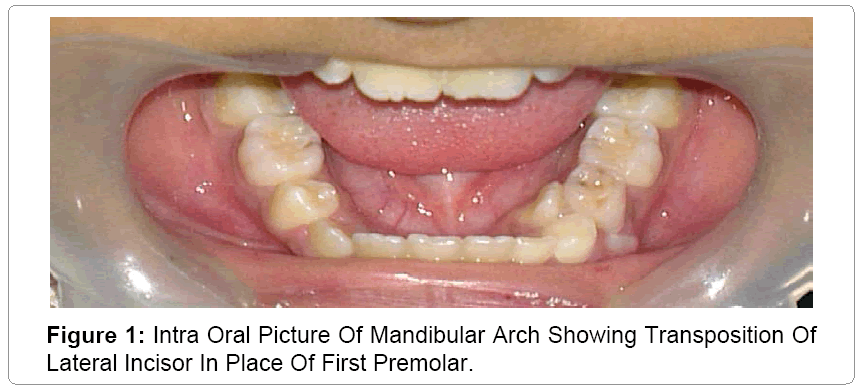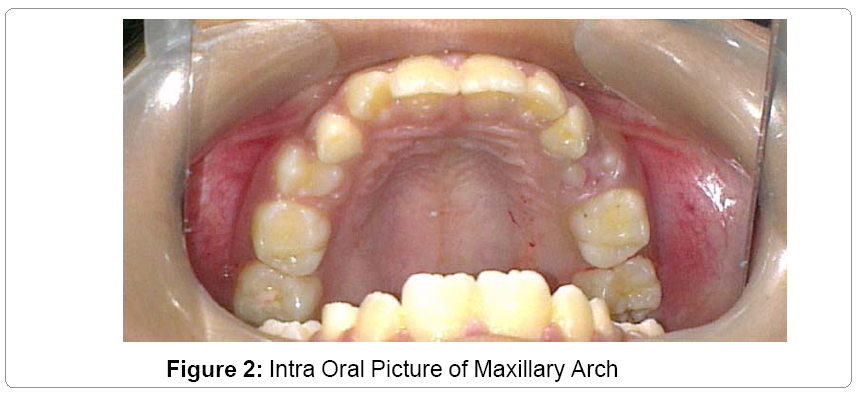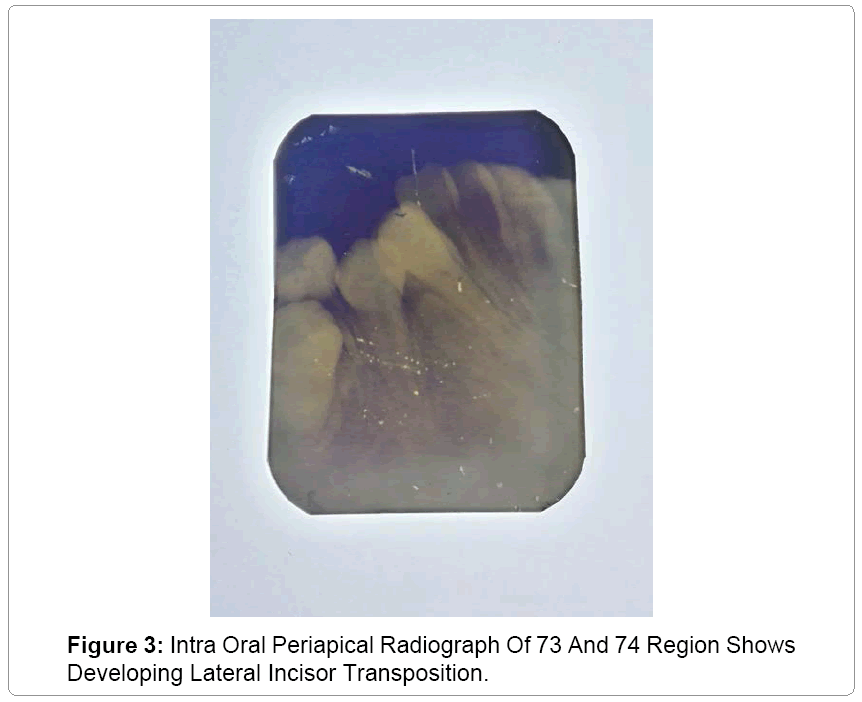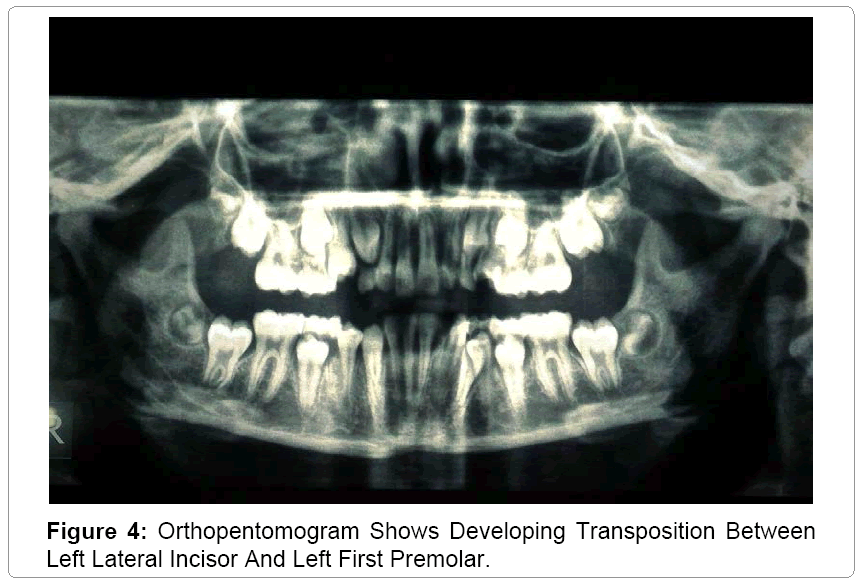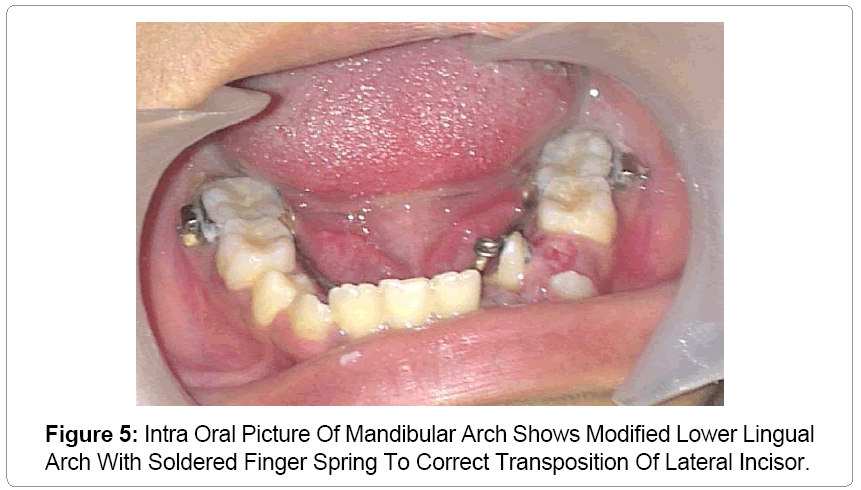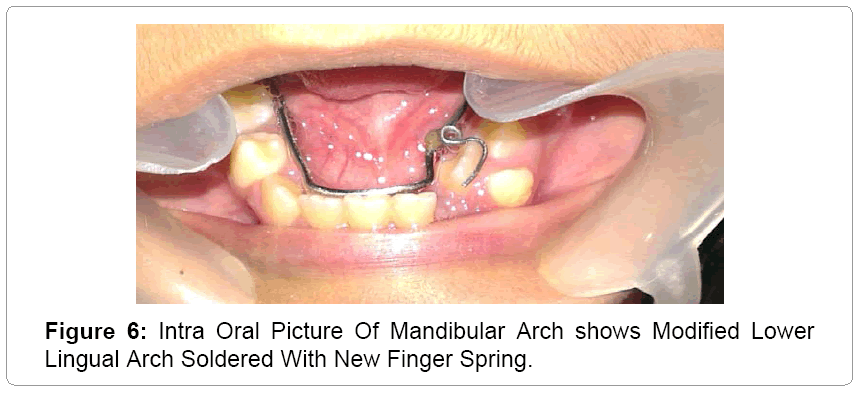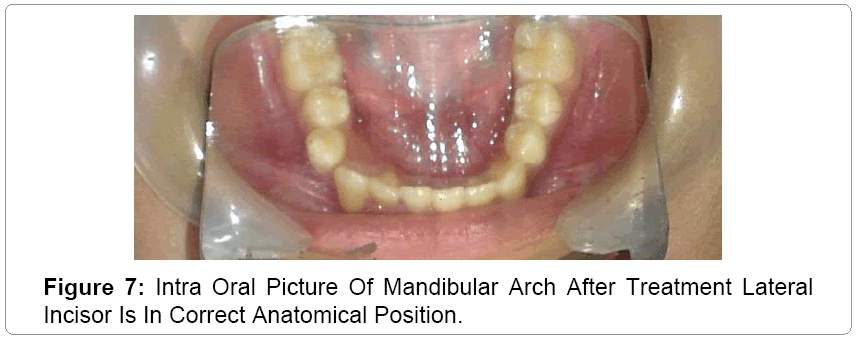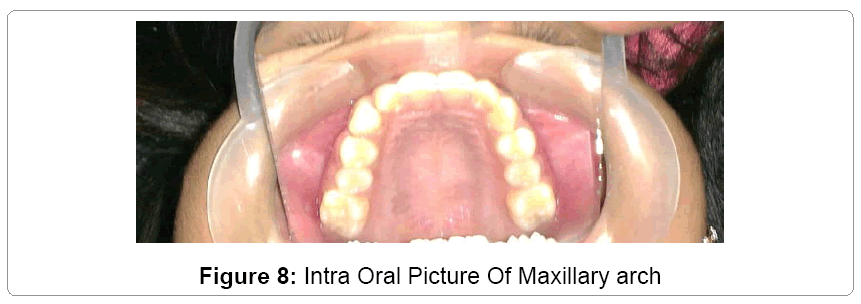Case Report Open Access
Early Diagnosis and Prevention of Complete Transposition of Mandibular Lateral Incisor during Mixed Dentition
Bhavesh Dinesh Trivedi*Associate Professor, Department of Pediatric and Preventive Dentistry, Sarjug Dental College and Hospital, Darbhanga, Bihar, India
- *Corresponding Author:
- Bhavesh Dinesh Trivedi
Associate Professor
Department of Pediatric and Preventive Dentistry
Sarjug Dental College and Hospital, Darbhanga, Bihar, India
Tel: 06272 233 775
E-mail: drbhavesh84@gmail.com
Received: December 28, 2015; Accepted: February 19, 2016; Published: February 25, 2016
Citation: Trivedi BD (2016) Early Diagnosis and Prevention of Complete Transposition of Mandibular Lateral Incisor during Mixed Dentition. Pediatr Dent Care 1:102. doi:10.4172/pdc.1000102
Copyright: © 2016 Trivedi BD . This is an open-access article distributed under the terms of the Creative Commons Attribution License, which permits unrestricted use, distribution, and reproduction in any medium, provided the original author and source are credited.
Visit for more related articles at Neonatal and Pediatric Medicine
Abstract
Transposition is a rare developmental disturbance of tooth order characterized by positional interchange of the two teeth. Transposition with adjacent tooth is very common but transposition with distant tooth is very rare. Early diagnosis of incomplete transposition during mixed dentition period intercepts the problem and prevents the developing complete transposition. The purpose of this paper was to present the advantage of early management of a rarely encountered transposition anomaly involving the mandibular permanent lateral incisor and the first premolar.
Keywords
Transposition; Developmental disturbance; Mixed dentition
Introduction
Dental transposition is a positional anomaly of the teeth which is described as the positional interchange of two adjacent teeth, or the development or eruption of a tooth in a position normally occupied by a non-adjacent tooth [1]. In some cases, transposition is caused by intra osseous migration and eruption of a single tooth into a distantly ectopic position, one ordinarily occupied by a nonadjacent tooth. It is an uncommon phenomenon, usually occurring unrelated to and independent of the commonplace condition of dental crowding. As such, tooth transposition is a designation applied to extreme types of ectopic eruption, each causing a change in the natural order of the permanent teeth.
Mandibular tooth transposition is seen less frequently and with less variety than those in the maxilla. Early detection and treatment during early mix dentition period can prevent transposition. In the present case report patient was in end of early mixed dentition period and ectopically erupted lateral incisor brought back into its correct anatomical position by modified lingual arch appliance.
Case Report
A 10 year old girl came with chief complaint of uneven placed teeth in the lower front region of jaw.
Intra Oral Examination
The clinical examination showed that the patient’s oral hygiene was good and periodontium was healthy. She was in the late mixed dentition stage and had class I skeletal and dental relationships. The over jet was 2 mm, and the overbite was 3 mm, which were within normal range. Mandibular left primary lateral incisor, canine and first deciduous molar were over retained. Mandibular left Permanent lateral incisor was erupted lingual to the left deciduous first molar and 1st premolar was erupting buccally to the left deciduous first molar. Right side permanent mandibular lateral incisor, canine and first premolar were erupted in correct order (Figure 1). Mixed dentition analysis showed there was enough space for eruption of all permanent teeth. In the upper arch teeth were erupting in to correct anatomical position and well aligned (Figure 2).
Radiological Examination
Intra oral per apical radiograph (with 73 and 74) (Figure 3) and orthopentomogram (Figure 4) was advised to see the position of left permanent lateral incisor, canine and first premolar. Radiographs shows permanent mandibular left canine was erupting in to its correct position, permanent mandibular left first premolar was erupting buccally to the first deciduous molar and permanent mandibular left lateral incisor was erupted lingual to the first deciduous molar. Intra oral per apical radiograph shows crown of left permanent mandibular lateral incisor was tipped distolingually placed lingual to over retained first deciduous molar and root was in its original position (incomplete transposition).
Treatment
Oral prophylaxis and oral hygiene instructions were given. All the over retained teeth, 72, 73 and 74 were extracted under local anesthesia. Lower lingual arch appliance soldered with finger spring at region of lower left permanent lateral incisor to tipped back in to its correct position (Figure 5). Periodically activation of finger spring was done by opening the helix on every fifteen days. After one and half month, old finger spring was removed and new finger spring was soldered for new position and to give correct force in correct direction (Figure 6). At the end of five months tooth was in correct anatomical position (Figures 7 and 8).
Discussion
Mandibular tooth transposition is seen less frequently and with less variety than those in the maxilla. Based upon data from published surveys, transpositions involving teeth in the mandible account for 15% to 30% of all tooth transpositions [2]. Mandibular transposition involving mainly canine and lateral incisor teeth [2,3] but transposition between permanent mandibular lateral incisor and premolar has never registered.
In addition to the classification of transposition cases according to the involved jaw and teeth, they are also classified as complete or incomplete transposition. The difference between the two types is that in a complete transposition case, crowns and roots of the involved teeth are in the transposed position although whereas in an incomplete transposition case the crowns may be transposed although the root apices remain in their normal positions [4]. There are several proposed factors regarding the aetiology of transposition abnormality. These include genetic interchange in the position of the developing tooth buds [1,2], altered eruption paths [5], presence of retained primary teeth [6], trauma [7] mechanical interferences to erupting permanent teeth, and early loss of deciduous teeth [8]. However, studies that have focused upon mandibular transposition have also found evidence for local rather than genetic factors being the predominant aetiological component [3,9]. Studies have shown that transposition is more frequently seen on the right side compared to left side [2]. In the present case report, incomplete transposition of permanent mandibular lateral incisor in place of first premolar was present on left side which is rare.
The main goal of treatment of all transposition abnormalities is to correct the positions of transposed teeth. Several factors including are patient’s age, occlusion, aesthetics, patient cooperation, periodontal support and treatment length should be taken into consideration in order to prevent any damage to the teeth and the supporting structures [10].
There are two different treatment approaches to treat transposition [8].
1. If the transposition is in an early stage, the position of the teeth can be corrected by the aid of fixed orthodontic treatment. However, one primary anterior tooth can be extracted to facilitate early correction.
2. If the transposition is recognized after the transposed teeth have erupted in their transposed position or where the roots of the involved teeth are parallel, it is not preferred to correct the position of the involved teeth. Because of the dense compact bone of the mandible, to correct the position of the teeth carries a high risk of damaging the teeth and supporting structures.
In the present case report, patient was in late mixed dentition stage with good periodontium health and enough space was present for eruption of permanent teeth. Patient was having incomplete transposition of mandibular lateral incisor (crown was transposed and root was in normal position) and first premolar hasn’t transposed. Due to early diagnosis in present case, incomplete transposition was possible to treat in its correct anatomical position with preventive and interceptive orthodontics. Lingual arch with finger spring modification is the most effective appliance to treat incomplete transposition at mixed dentition period. We suggest patient should call for regular dental check up every three months during 6 years to 13 years to guide eruption of permanent teeth, to prevent and treat malocclusion and anomaly like incomplete transposition.
Conclusion
Transposition is rare and in that mandibular transposition involving left mandibular lateral incisor and premolar is very rare. Early diagnosis and management during mixed dentition period with preventive and interceptive orthodontics is most effective and easy way to treat such anomaly and that will prevent fixed orthodontics.
References
- Peck L, Peck S, Attia Y (1993) Maxillary Canine-First Premolar Transposition, Associated Dental Anomalies and Genetic Basis. Angel Orthod63:99-109.
- Peck S, Peck L, Kataja M (1998) Mandibular Lateral Incisor-Canine Transposition, Concomitant Dental Anomalies, and Genetic Control. Angle Orthodontist 68:455-466.
- Plunkett DJ, Dysart PS, Kardos TB, Herbison GP (1998) A Study Of Transposed Canines In A Sample Of Orthodontic Patients. British Journal of Orthodontics25:203-208.
- Shapira Y, Kuftinec MM (1989) Tooth Transpositions - A Review ofThe Literature And Treatment Considerations. Angle Orthod59:271-276.
- Gholston LR, William PR(1984) Bilateral Transposition of Maxillary Canines and Lateral Incisors: A Rare Condition. Journal of Dentistry for Children 51:58-63.
- Laptook T, Silling G (1983) Canine Transposition - Approaches To Treatment. Journal ofthe American Dental Association 107:746-748.
- Dayal PK, Shodhan KH, Dave CJ (1983) Transposition of Canine with Traumatic Etiology. Journal of the Indian Dental Association 55:283-285.
- Canoglu E,Kocadereli I,Turgut MD (2009) Alignment of Transposed Mandibular Lateral Incisor and Canine Using Removable Appliances.Aust Dent J54:266-70.
- Shapira Y, Kuftinec MM (2001) Maxillary Tooth Transpositions: Characteristic Features and Accompanying Dental Anomalies. American Journal of Orthodontics AndDentofacial Orthopedics 119:127-134.
- Maia FA (2000) Orthodontic Correction of A Transposed Maxillary Canine and Lateral Incisor. Angle Orthod70: 339-348.
Relevant Topics
- About the Journal
- Birth Complications
- Breastfeeding
- Bronchopulmonary Dysplasia
- Feeding Disorders
- Gestational diabetes
- Neonatal Anemia
- Neonatal Breastfeeding
- Neonatal Care
- Neonatal Disease
- Neonatal Drugs
- Neonatal Health
- Neonatal Infections
- Neonatal Intensive Care
- Neonatal Seizure
- Neonatal Sepsis
- Neonatal Stroke
- Newborn Jaundice
- Newborns Screening
- Premature Infants
- Sepsis in Neonatal
- Vaccines and Immunity for Newborns
Recommended Journals
Article Tools
Article Usage
- Total views: 13062
- [From(publication date):
specialissue-2016 - Apr 03, 2025] - Breakdown by view type
- HTML page views : 12059
- PDF downloads : 1003

